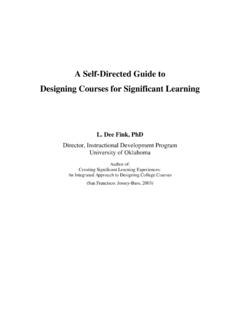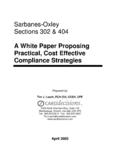Transcription of A Self-Directed Guide to Designing Courses for Significant ...
1 A Self-Directed Guide to Designing Courses for Significant learning L. Dee Fink, PhD Director, Instructional Development Program University of Oklahoma Author of: Creating Significant learning Experiences: An Integrated Approach to Designing College Courses (San Francisco: Jossey-Bass, 2003) i A Self-Directed Guide to Designing Courses for Significant learning TABLE OF CONTENTS Introduction 1 An Overview of Integrated course Design 2 Model 1: The Key Components of Integrated course Design 2 Designing an Integrated course 4 Initial Design Phase: Building Strong Primary Components 4 Preview of the Initial Design Phase: Designing Courses that Promote .. 5 Step 1. Situational Factors 6 Step 2. learning Goals 8 Step 3. Feedback and Assessment 13 Step 4.
2 Teaching/ learning Activities 16 Active learning 16 Rich learning Experiences 19 In-Depth Reflective Dialogue 19 Information and Ideas 21 Step 5. Integration 21 Final Check and Review of Initial Phase 23 Model 2: Criteria for Assessing course Designs 24 Intermediate Design Phase: Assembling the Components into a Coherent Whole 25 Step 6. course Structure 25 Step 7. Instructional Strategy 26 Step 8. Creating the Overall Scheme of learning Activities 27 Final Design Phase: Important Remaining Tasks 30 Step 9. How Are You Going to Grade? 30 Step 10. What Could Go Wrong? 31 Step 11. Let Students Know What You Are Planning 31 Step 12. How Will You Know How the course Is Going? How It Went? 32 Concluding Counsel 33 1 A Self-Directed Guide TO Designing Courses FOR Significant learning Introduction.
3 When we teach, we engage in two closely related, but distinct, activities. First, we design the course by gathering information and making a number of decisions about the way the course will be taught. Second, we engage in teacher-student interactions as we implement the course we have designed. The concept of Teacher-Student Interaction as used here is a broad one that includes lecturing, leading discussions, running labs, advising, communicating by email, etc. In order to teach well, one must be competent in both course design and teacher-student interactions. However, of these two activities, our ability to design Courses well is usually the most limiting factor. Most of us have had little or no training in how to design Courses . In addition during the last two decades, research on college teaching and learning have led to some new ideas about course design that have, in essence, raised the bar in terms of what is possible.
4 These include ideas such as active learning , Significant learning , and educative assessment. How can college teachers learn about and take advantage of these ideas? This Self-Directed Guide is intended to introduce a useful and systematic process for Designing Courses . It is based on the same components found in most models of instructional design, but it assembles these components into a relational, integrated model rather than a linear one. Among other benefits, this model provides clear criteria for determining when a course design is a good design. This Guide consists of introductory comments, worksheets, and action questions in each of the three major phases of Integrated course Design: INITIAL DESIGN PHASE: Build Strong Primary Components Step 1. Identify important situational factors Step 2. Identify important learning goals Step 3.
5 Formulate appropriate feedback and assessment procedures Step 4. Select effective teaching/ learning activities Step 5. Make sure the primary components are integrated INTERMEDIATE DESIGN PHASE: Assemble the Components into a Coherent Whole Step 6. Create a thematic structure for the course Step 7. Select or create an instructional strategy Step 8. Integrate the course structure and the instructional strategy to create an overall scheme of learning activities FINAL DESIGN PHASE: Finish Important Remaining Tasks Step 9. Develop the grading system Step 10. De-Bug possible problems Step 11. Write the course syllabus Step 12. Plan an evaluation of the course and of your teaching 2 Read through the introductory comments in each step, and then complete as much of each worksheet and action item as you can.
6 If you don t fully understand a particular idea or have difficulty applying it to your own course , do what you can, and then move on. Generally you will be able to come back later and the ideas that you need will be clearer. In this Guide , I first present an overview of Integrated course Design and then work through each of the major phases, one at a time. An Overview of Integrated course Design The basic components in this model of Integrated course Design are the same as those found in other models of instructional design: analyze the situational factors, formulate the learning goals, design the feedback and assessment procedures, and select the teaching/ learning activities. What is distinctive about this model is that these components have been put together in a way that reveals and emphasizes their inter-relatedness.
7 (See Model 1 below) Model 1 The Key Components Of INTEGRATED course DESIGN One of the benefits of this model is that it allows us to see the importance S i t u a t i o n a l F a c t o r s Teaching and learning Activities Feedback & Assessment learning Goals 3 One of the benefits of this model is that it allows us to see the importance of an integrated course and to know when we have one and when we do not. To illustrate this point, let me describe an extreme case of a un-integrated or dis-connected course . Imagine a course in which the teacher says s/he wants students to (a) learn all the important content and (b) learn how to think critically about the subject. These are the learning goals. But when you examine what actually happens in class, it is a straight lecture course (this is the teaching/ learning activity ).
8 This creates the first problem: the teaching/ learning activities are NOT aligned with the learning goals. The students might be able to learn the content from the lectures, but they definitely are not getting practice and feedback in learning how to think critically. Now notice the dilemma this teacher faces when s/he attempts to write the mid-term or final exam. S/he can legitimately ask understand and remember questions, , content-related questions. But should s/he include thinking questions or not? If s/he does, the assessment part of the course will be properly connected to the learning goals. But the students will do poorly because they have not had the appropriate learning activities for critical thinking; hence there will also be a disconnect between the learning activities and any assessment on critical thinking.
9 (The diagram below illustrates the situation when the teacher chooses this option.) On the other hand, if the teacher chooses not to include thinking questions on the exam, the assessment will be consistent with the teaching/ learning activities but not with the learning goals. (This option is shown in the following diagram.) learning Goals Teaching/ learning Activities Feedback & Assessment Integration Problem: Example 1 learning Goals Teaching/ learning Activities Feedback & Assessment Integration Problem: Example 2 4 Notice the pattern: If a teacher breaks one of the connections in a course , inevitably another is broken. When two out of three key connections are broken, the course itself is broken. This is why it is so important to create an integrated design. Designing an Integrated course .
10 In Designing a course , we are gathering informa-tion and making decisions about how the course will be taught. We want to engage in both of these activities so that there is a high likelihood that the students will have a Significant learning experience. In order to do this, we need to work through the course design process in a systematic way. This means completing each step before going on to the next one. This is important because the later steps build on the earlier ones. For Integrated course Design (Model 1), start by building strong primary components (INITIAL DESIGN PHASE); then assemble them into a coherent whole (INTER-MEDIATE DESIGN PHASE); and finally, finish several important tasks (FINAL DESIGN PHASE). INITIAL DESIGN PHASE (Steps 1-5): Building Strong Primary Components The primary components of Integrated course Design are shown in Model 1.









